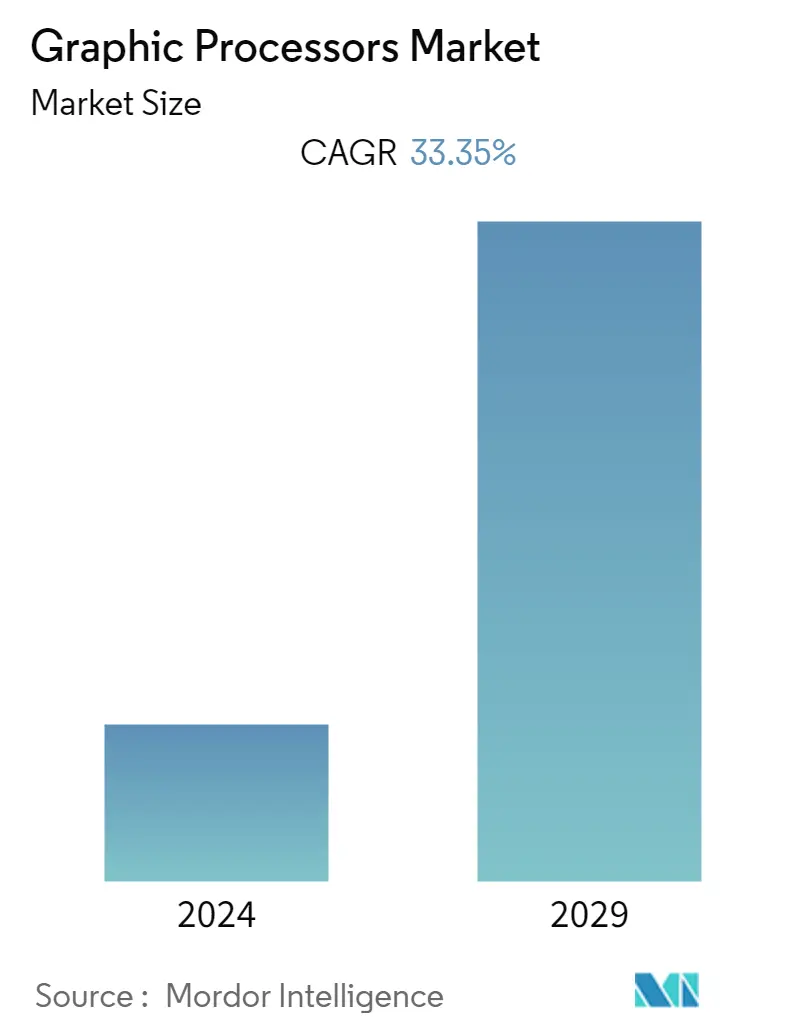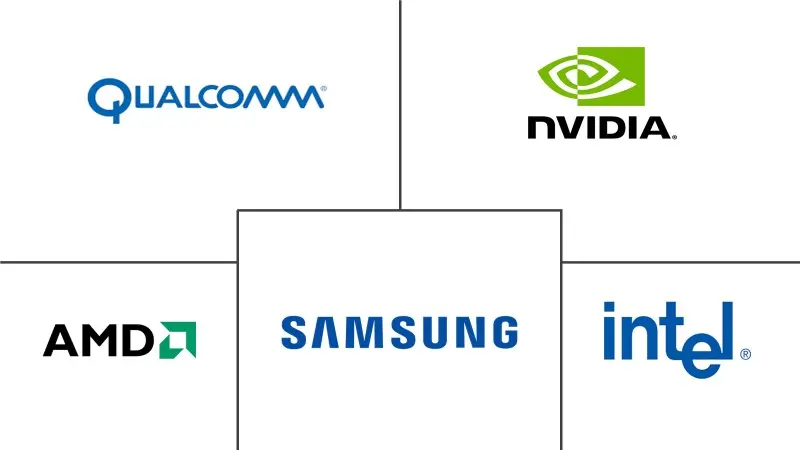Market Size of Graphic Processors Industry

| Study Period | 2019 - 2029 |
| Base Year For Estimation | 2023 |
| CAGR | 33.35 % |
| Fastest Growing Market | Asia Pacific |
| Largest Market | North America |
| Market Concentration | High |
Major Players
*Disclaimer: Major Players sorted in no particular order |
Graphic Processors Market Analysis
The graphic processors market is expected to register a CAGR of 33.35% over the forecast period. According to the ITA, the United States media & entertainment industry is expected to reach more than USD 825 billion by next year. The industry's rapid growth will trigger the adoption of desk-based PCs and tablets with high-end graphics cards and processors to enhance the gaming experience.
- The market for gaming applications is rising due to increased consumer spending on tablets, smartphones, and notebooks, driving the demand for graphics processors to provide high-quality visual effects and high-speed gaming applications.
- The factor fueling the graphic processor market's growth is the increasing usage of processors to support graphics applications and 3D content in various industry verticals such as manufacturing, automotive, real estate, and healthcare. For instance, to support manufacturing and design applications in the automotive sector, CAD and simulation software leverages GPUs to create photorealistic images or animations.
- The rise of geographic information systems (GIS) and immersive multimedia are also driving the graphics processing market. Increasing usage of applications such as GIS that provide real-time spatial and geographical data is rising owing to the penetration of smartphones, tablets, and other mobile computing devices. A GIS allows users to generate a query, analyze spatial information, map data, and provide output. However, to provide real-time information, mobile computing devices incorporate graphic processors on a large scale.
- The metaverse offers an enhanced experience. Many activities people can perform in the real world are also possible in this virtual representation of the real world. The software will need to advance to support this because interoperability between platforms, applications, and services will be essential for a working ecosystem. Hardware will be essential to allow people to interact with this new online environment, despite software being an important pillar in the convergence of different realities.
- With full-body haptics and virtual reality equipment still available, AR and VR technologies will likely be the primary ways of experiencing the metaverse during the transition. This offers enormous potential for the electronics sector, particularly from the perspective of GPUs, to spearhead widespread innovation that will aid in immersing users while utilizing parallelism to address data issues.
- Moreover, the inability to properly balance system performance, efficiency, and power consumption poses a challenge to market growth. Further, declining workstation sales may hamper the graphic processors' market growth over the forecast period.
Graphic Processors Industry Segmentation
Graphics processors are devices used for the purpose of accelerating a wide range of tasks, from drawing simple text and graphics on a computer to designing and analyzing complex three-dimensional (3D) models. A graphics processor is a single-chip processor that boosts the performance of video and graphics and is used to lower the burden on the CPU. Graphic processors are used in embedded systems, consoles, workstations, personal computers, and mobile phones to deliver faster performance and better rendering.
The Graphic Processors Market is Segmented by Type (Dedicated Graphics Card, Integrated Graphics Solutions, and Hybrid Solutions), by Deployment(On-premise, Cloud), by Applications (Smartphones, Tablets and Notebooks, Workstations, Gaming PC, Media and Entertainment, and Automobiles), and by Geography (North America, Europe, Asia-Pacific, Latin America, and Middle East & Africa).
The market sizes and forecasts are provided in terms of value (USD million) for all the above segments.
| By Type | |
| Dedicated Graphics Card | |
| Integrated Graphics Solutions | |
| Hybrid Solutions |
| By Deployement | |
| On-premise | |
| Cloud |
| By Applications | |
| Smartphones | |
| Tablets and Notebooks | |
| Workstations | |
| Gaming PC | |
| Media and Entertainment | |
| Automotives |
| Geography | |
| North America | |
| Europe | |
| Asia-Pacific | |
| Latin America | |
| Middle East and Africa |
Graphic Processors Market Size Summary
The graphic processors market is poised for significant growth, driven by the increasing demand for high-quality visual effects and high-speed gaming applications across various platforms, including desktops, tablets, and mobile devices. The rise in consumer spending on gaming hardware and the proliferation of mobile computing devices are key factors propelling this market expansion. Industries such as manufacturing, automotive, real estate, and healthcare are increasingly utilizing graphic processors to support advanced graphics applications and 3D content, further fueling market growth. The integration of graphic processors in geographic information systems (GIS) and immersive multimedia applications is also contributing to the market's upward trajectory. Additionally, the burgeoning metaverse and the advancements in AR and VR technologies present substantial opportunities for graphic processors, as they play a crucial role in enhancing user experiences and enabling seamless interactions in virtual environments.
The market landscape is characterized by intense competition among major players like NVIDIA, AMD, Intel, and Qualcomm, who are continuously innovating and expanding their product portfolios to maintain a competitive edge. The Asia-Pacific region, particularly countries like China, Japan, and India, is witnessing a surge in demand for graphic processors, driven by the growing adoption of gaming applications and smart devices. The region's technological advancements and high consumer spending on gaming further bolster market prospects. However, challenges such as balancing system performance with power consumption and declining workstation sales may impact market growth. Despite these challenges, the graphic processors market is expected to thrive, supported by ongoing technological innovations and strategic developments by key industry players.
Graphic Processors Market Size - Table of Contents
-
1. MARKET DYNAMICS
-
1.1 Market Overview
-
1.2 Introduction to Market Drivers and Restraints
-
1.3 Market Drivers
-
1.3.1 Increasing Demand for Graphic Applications
-
1.3.2 Rise of Geographic Information Systems (GIS) and Immersive Multimedia
-
-
1.4 Market Restraints
-
1.4.1 Declining Workstation Sales
-
-
1.5 Industry Value Chain Analysis
-
1.6 Industry Attractiveness - Porter's Five Force Analysis
-
1.6.1 Bargaining Power of Buyers/Consumers
-
1.6.2 Bargaining Power of Suppliers
-
1.6.3 Threat of New Entrants
-
1.6.4 Threat of Substitute Products
-
1.6.5 Intensity of Competitive Rivalry
-
-
-
2. MARKET SEGMENTATION
-
2.1 By Type
-
2.1.1 Dedicated Graphics Card
-
2.1.2 Integrated Graphics Solutions
-
2.1.3 Hybrid Solutions
-
-
2.2 By Deployement
-
2.2.1 On-premise
-
2.2.2 Cloud
-
-
2.3 By Applications
-
2.3.1 Smartphones
-
2.3.2 Tablets and Notebooks
-
2.3.3 Workstations
-
2.3.4 Gaming PC
-
2.3.5 Media and Entertainment
-
2.3.6 Automotives
-
-
2.4 Geography
-
2.4.1 North America
-
2.4.2 Europe
-
2.4.3 Asia-Pacific
-
2.4.4 Latin America
-
2.4.5 Middle East and Africa
-
-
Graphic Processors Market Size FAQs
What is the current Graphic Processors Market size?
The Graphic Processors Market is projected to register a CAGR of 33.35% during the forecast period (2024-2029)
Who are the key players in Graphic Processors Market?
NVIDIA Corporation, Advanced Micro Devices Inc., Intel Corporation, Samsung Electronics Co. Ltd. and Qualcomm Incorporated are the major companies operating in the Graphic Processors Market.

